FTA (изд-во). Flexography: Principles And Practices. Vol.1-6
Подождите немного. Документ загружается.

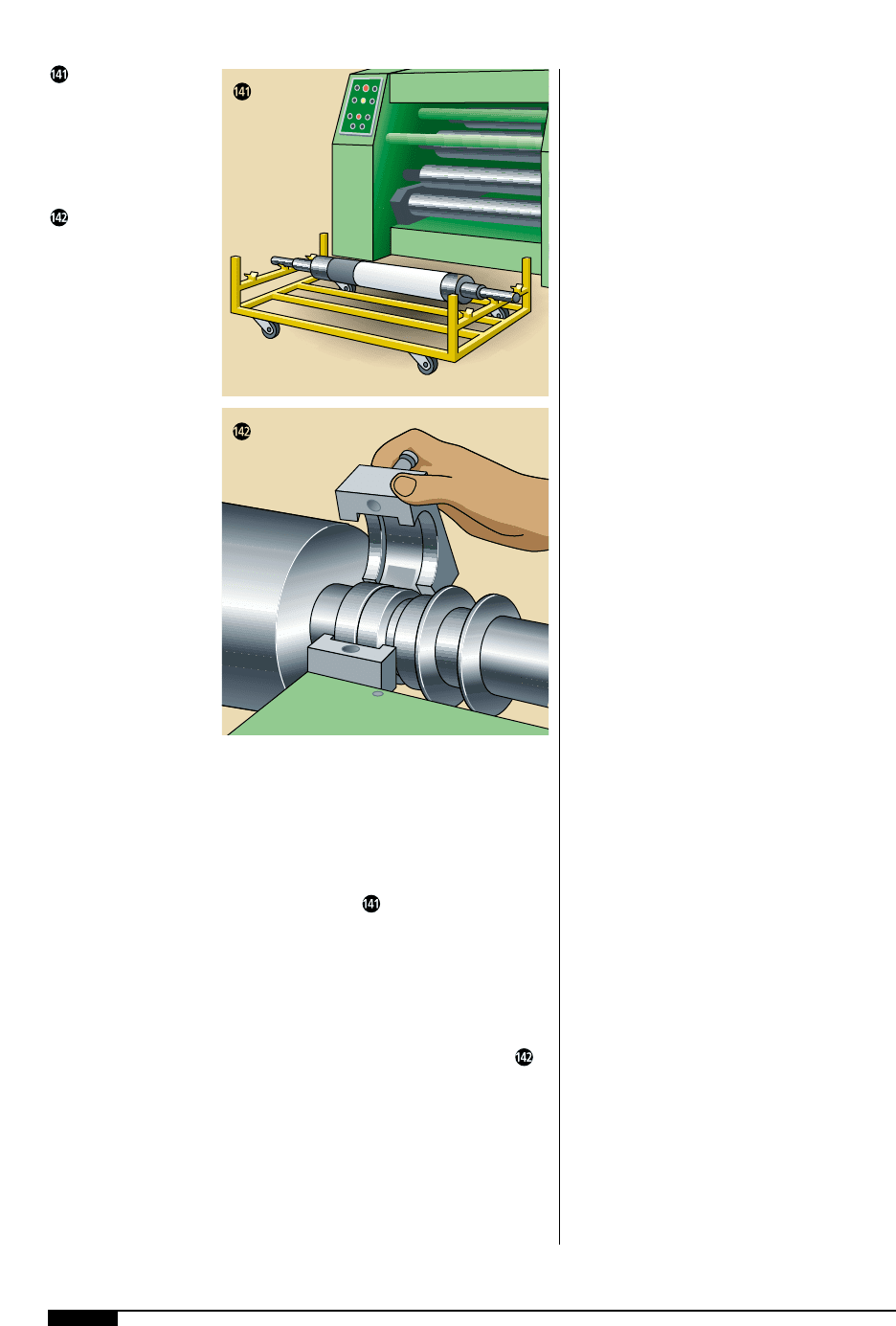
196 FLEXOGRAPHY: PRINCIPLES & PRACTICES
appropriate print stations.
Wide-web plate cylinders are extremely
heavy, thus requiring the operator to use
carts and/or hoists for the safe handling of
cylinders (Figure ). Operators must use
caution when loading print cylinders into the
press to prevent the plate surfaces from
being bumped and damaged. After all the
cylinders are loaded into place, bearing caps
must be installed and tightened to keep the
roll stable during the pressrun (Figure ).
Ink the Print Stations
The next step in the setup procedure is to
ink up the print stations. The following pro-
cedure details a typical print station inking:
1. Double check the color in the ink con-
tainer to verify that it is the color to be
placed in that print station.
2. Circulate the ink in the ink pump
through the supply hose back into the
pump to remove air from the system.
3. If an ink pan is being used, align the
ink pan and lock down the hold down
mechanism. Ensure that the pan will
not rub on the ends of any rolls or the
surface of the plate cylinder.
4. Connect the return hoses from the ink
pan to the ink pump, making sure they
are routed around any moving parts.
With water-based inks, return hoses
must be slightly submerged in the ink
of the ink pumping unit to help avoid
foaming.
5. Connect the supply hose from the
pump to the ink distribution system.
6. Pump the ink into the distribution sys-
tem.
7. After the ink has been pumping for a
time, take the viscosity (pH and vis-
cosity for water-based inks) to ensure
that the ink is at its running parame-
ters. If the ink is not at its running para-
meters, it should be adjusted and
rechecked to meet specifications be-
fore the pressrun begins.
Set the Fountain Roll
and/or Doctor Blade
Once the ink is in the fountain and is with-
in its recommended running pH and viscos-
ity parameters, the anilox roll may be inked.
When using a two-roll system, the fountain
roll is adjusted to squeeze against the anilox
roll. Once the press is started, the rubber roll
is adjusted so that it evenly squeezes the ink
off the anilox using the minimum amount of
pressure. This pressure setting is checked by
backing the fountain roll off until the operator
can see the nip flood with ink. Then the oper-
ator squeezes back in with both sides of the
rubber roll, making sure they are even, until
the flooding on the surface goes away. By
doing this several times, the ink wipe is set.
Due to the heavy
weight of wide-web
plate cylinders, most
operations use carts
for the safe handling of
cylinders.
When installed and
tightened, bearing caps
keep the roll stable
during the pressrun.
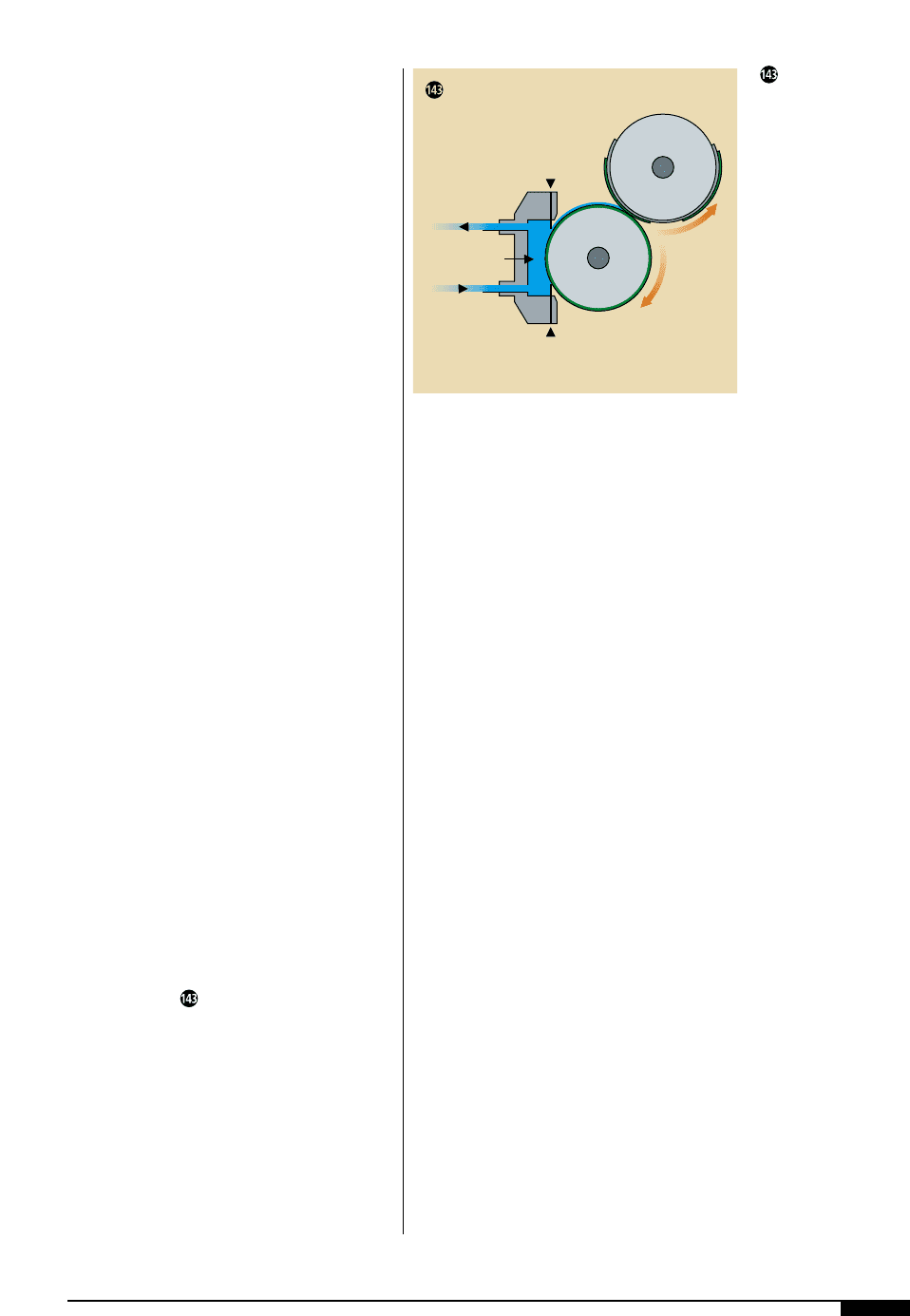
pression slightly so the plate comes
into contact with the web.
2. Turn in the anilox-to-plate adjustment
to begin inking the plate. While looking
at the print on the web, make adjust-
ments to the impression and ink set-
tings until there is a clear print with no
images missing.
3. Similar to the setting of the rubber roll
or doctor blade, back in and out on the
settings to achieve ink and impression
settings with the minimum amount of
pressure.
4. Set the remaining ink and impression
settings, working backward to each
print station in order from last to first.
5. After all the settings are complete for
each print station, adjust for color-to-
color registration. Start with the first
station (front of the press) and set reg-
ister for each station in order.
6. Once all the colors for the job are in
register with each other, check print-
to-die registration. Register the die cut-
ter and slitter to the printed image. In
all flexo press settings, it is important
to use the minimum amount of pres-
sure to do the job.
Check Colors to Standard
Once the press is set up and all settings are
PRESSROOM PRACTICES 197
A chambered doctor-
blade assembly should
be installed before the
pump is turned on. The
ink wipe should be set
in the same manner as
a single blade, and
there is no rubber roll
to set.
On some wide-web presses, a doctor blade
is used in conjunction with the rubber foun-
tain roll. In this case the doctor blade must
be set to meter the anilox roll.
When setting a station with a doctor blade,
the fountain roll pressure should be set a lit-
tle loose. This setting allows for extra ink to
go through to the doctor blade where it is
metered off. The doctor blade assembly is
set into its holder and then slowly tightened
down until it touches the anilox. As the
blade is tightened to the anilox, the operator
will notice that the ink will meter from the
center of the anilox roll outward to the ends.
When the ink is metered off the ends of the
anilox roll, the wipe is set. Similar to the pro-
cedure for setting fountain roll pressure, the
doctor blade should be backed out and
brought back in to the anilox several times
in order to set the wipe with the minimum
amount of pressure. Overtightening the doc-
tor blade can cause the blade to fold under
the pressure, causing the ink to dry due to
the friction and heat buildup behind the
blade. If ink drying occurs, the dried ink pig-
ments can cause damage to the anilox roll.
Once the ink is metered correctly, cover
the fountains with the ink-fountains covers.
The covers reduce the amount of amine or
solvent that evaporates out of the ink to help
keep the ink more stable during the pressrun.
If the press is equipped with a chambered
doctor-blade assembly, the assembly is
installed before the pump is turned on. The
ink wipe should be set in the same manner
as a single blade, and there is no rubber roll
to set (Figure ).
Set Impression,
Inking, and Registration
The following procedure details a typical
impression, inking and registration setup:
1. With the press running at a slow speed,
start with the last color to be printed
and achieve the correct impression
and ink settings. Turn down the im-
Plate
Cylinder
Anilox Roll
Reservoir
Ink “Out”
Return
Ink “In”
Supply
Containing
Doctor Blade
Metering
Doctor Blade
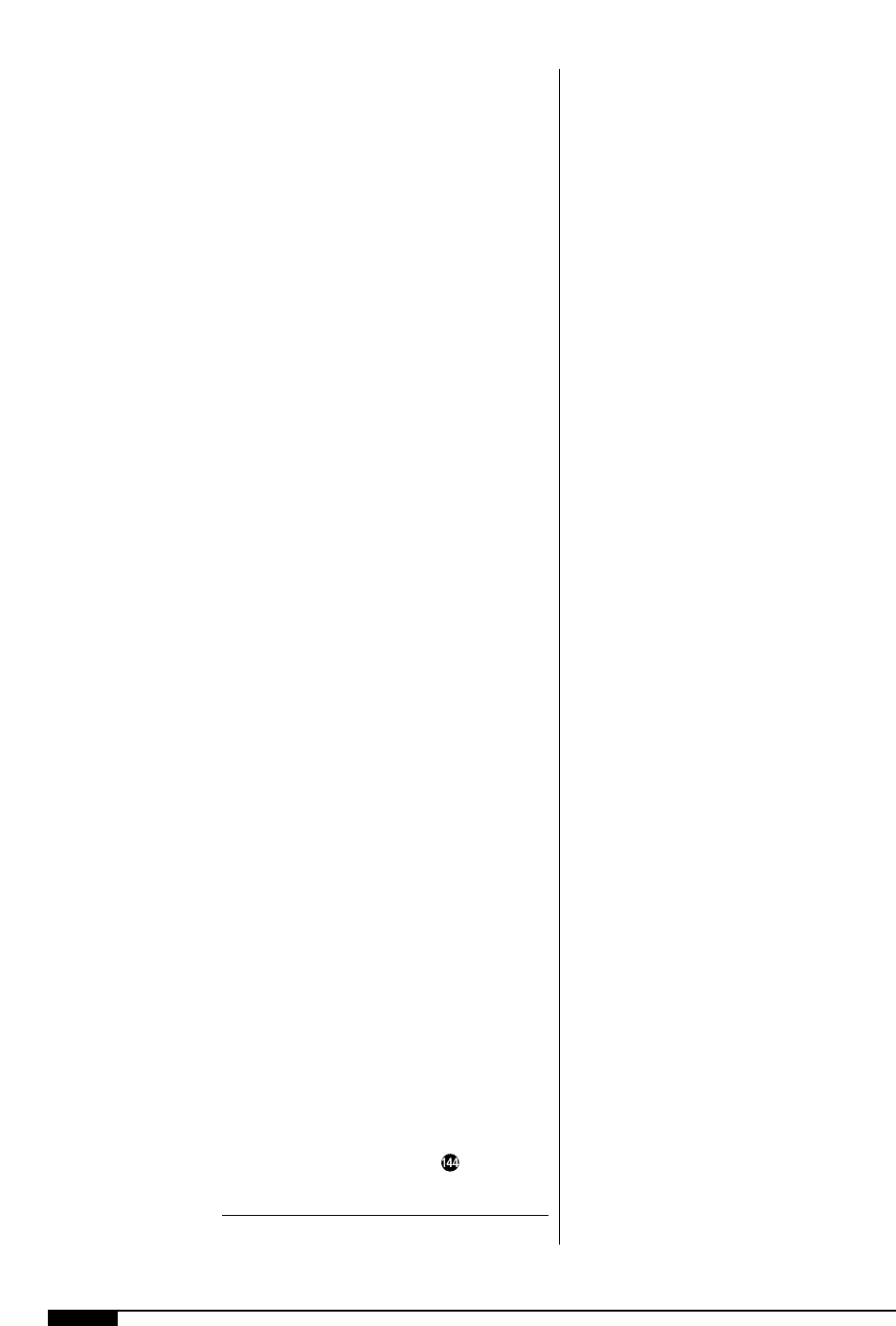
198 FLEXOGRAPHY: PRINCIPLES & PRACTICES
complete, the printing must be checked for
accuracy against a color standard that has
been approved by the customer in the design
stage of the job. A color standard may be a
previously printed sample, a Pantone
®
11
sample, an ink drawdown or a spectropho-
tometer reading.
All visual color matching should take
place in a viewing booth designed for this
purpose. This type of booth provides a stan-
dardized light source with a neutral gray
background to check color, eliminating the
color variations during the color-matching
process caused by lighting conditions.
A sample of the print should be compared
to the color standard to ensure that the
printed job meets the customer’s require-
ments. The operator should check to make
sure the color is printing at the correct den-
sity (lightness and darkness) either visually
or with the use of a densitometer. If the color
is not printing at the correct density, the
anilox may be changed to achieve a density
match with the standard. This change is
especially useful when working with ultravi-
olet inks. For slight density changes that are
needed when working with conventional
inks, the ink viscosity may be changed by
adding solvent, or the ink may be extended
to reach the color standard.
The ink hue should also be checked visu-
ally in a light booth or with the aid of a spec-
trophotometer. If changes in hue are needed,
the operator should add the correct ink bases
to reach the color standard. All of the infor-
mation from the color matching process
should be documented so the job can be
reprinted without additional downtime.
Approval Form
Many companies use a checklist approval
form that is filled out after the job has been
set up and approved (Figure ). This form
helps ensure that all the details for printing
the job have been covered and that the job
matches the specifications on the job jacket.
The goal in setting up any wide-web flexo-
graphic press is to minimize the preparation
time to get the job running quickly. This tim-
ing requires efficient teamwork between all
production personnel. Operators must antic-
ipate the next task to be completed during
the setup to reduce downtime. A press will
only make money when it is in production.
Setup time is expensive.
PRESSRUN PROCEDURES
Once the press is running, there are quite a
few other areas that must be checked regu-
larly. Here’s what needs to be done next…
Ink Viscosity and pH
Maintaining viscosity, or pH and viscosity
in the case of water-based inks, is essential
for producing consistent print throughout
the production run. If an ink is color-
matched at a 25-second viscosity, a higher
viscosity will make the color print darker. A
higher viscosity occurs because the solvent
or amines evaporate out of the ink during
the pressrun, causing the customer’s prod-
uct to become inconsistent as the run pro-
gresses. In order to maintain the same den-
sity of print throughout the pressrun, viscos-
ity (solvent based inks), or pH and viscosity
(water-based inks), must be maintained.
When doctor blades or chamber blade sys-
tems are used, high viscosity inks will cause
ink starvation by not reloading the anilox
cells. The print will not be consistent and the
color variations in the product will not be
acceptable to the customer. If the ink is run-
ning at a lower viscosity than the viscosity of
the color match, the color will get lighter. If
the viscosity gets too close to the minimum
running viscosity for that ink, printing
defects may occur.
Controlling Ink Viscosity and pH. Viscosity
11
Pantone, PMS and the Pantone Matching System are trademarks of Pantone,
Inc.
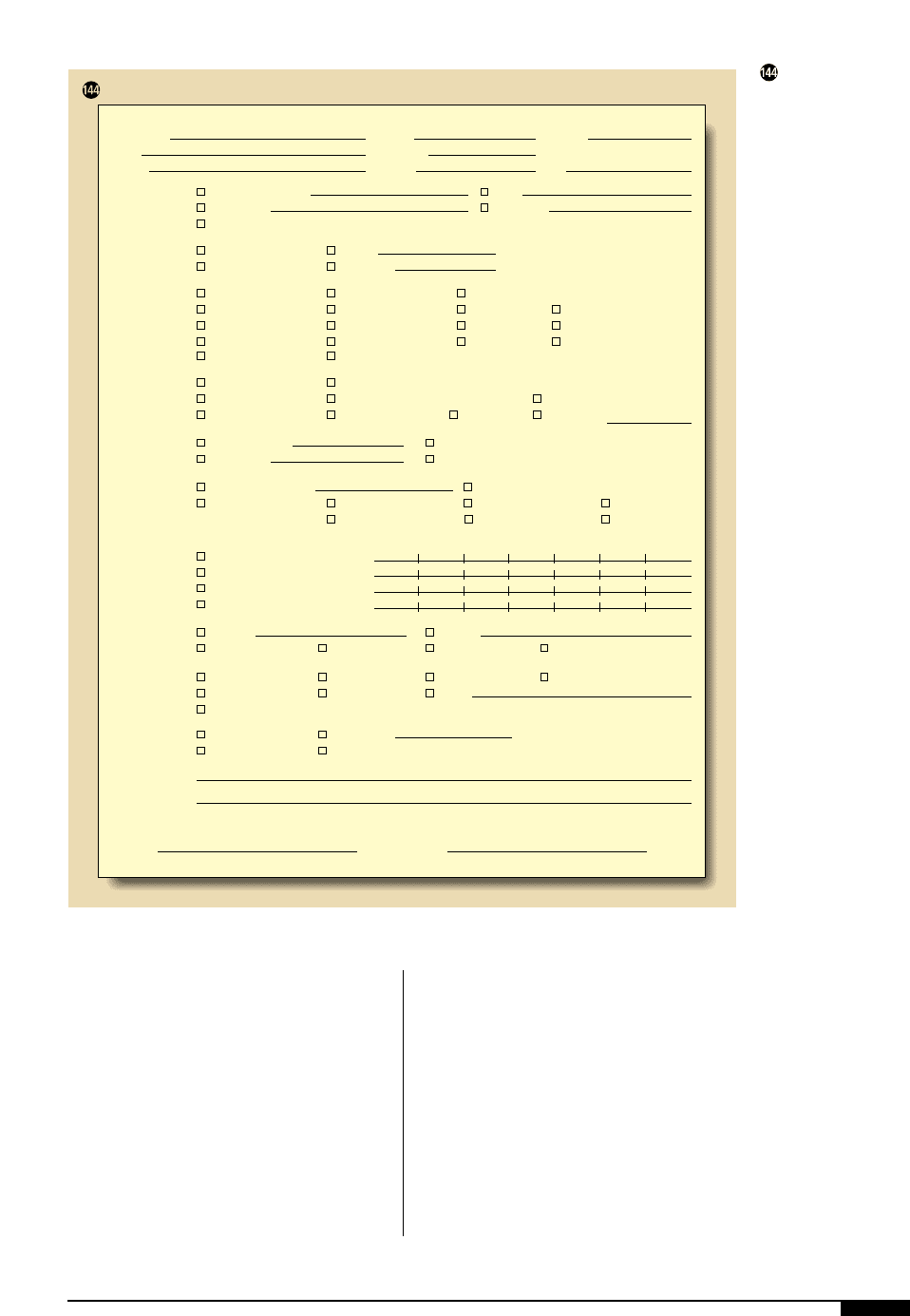
checks should be completed every 10 to 15
minutes when using solvent-based inks.
When using water-based inks, pH and vis-
cosity should be checked every 30 minutes.
It is important to check pH first, followed by
viscosity, when using water-based inks
because the viscosity is affected by the pH
level. Solvent inks require more frequent
checks of viscosity since the solvent evapo-
rates quickly and is more unstable than the
water in water-based inks.
To control an ink’s viscosity, small amounts
of a reducer should be added. The viscosity
level should never get so high that it takes
more than a pint of reducer to return the vis-
cosity to the correct level. Careful control of
ink viscosity (pH and viscosity for water-
based inks) results in consistent color and
uniform ink flow throughout the job run.
To control solvent-based ink viscosity, sol-
vent reducer is added during the pressrun.
The make-up solvent should have a slightly
PRESSROOM PRACTICES 199
A checklist approval
form should be filled
out after setup has
been completed and
approved.
SUPERVISOROPERATOR
I HAVE MADE ALL THE APPLICABLE CHECKS AND APPROVE THIS ORDER FOR START-UP.
COMMENTS:
BOXES
LABELING
STANDARD
STANDARD
NEXT
OPERATION
INK
SPECIAL SIZE
SPECIAL
REWINDER
SHRINKWRAPPING
SHIPPING FROM PRESS
FANFOLDING
PADDING
TRIMMER
OTHER
TIPPING
WRITE ON
PRIMER
FACE COPY—WATER BASED
FACE COPY—SOLvENT BASED
BACK COPY—WATER BASED
BACK COPY—SOLVENT BASED
1)
1)
1)
1)
2)
2)
2)
2)
COPY REGISTRATION REWIND
READ
QUALITY LEVEL
COLOR SEPARATIONS
IMPRESSION
2
NO SPLICES SIZE OF FOLD
PINFEED HOLE ALIGNMENT
UV CURING
VARNISH
TAPE TEST RUB TEST
LIST PMS COLORS
POSITION
1
QUALITY
3
MISC. MACHINE COUNT:
% OVERRUN
FANFOLD FOLDING STRAIGHT
CUTTING CLEAN
POSITION OF FOLD
PERF TEARS CORRECTLY (NOT TOO HARD/NOT TOO EASY)
HINGE FOLDING CORRECTLY
SPLICES REQUIRED
DIE CUTS HAND APPLIED
REGISTRATION
PERFED
CUTTING CLEAN
SINGLES LAY FLAT
MACHINE APPLIED
DIE CUT
SCORED
LINER TEST
JOG EVEN SIZE
MULTIWEB
OR COUPON
CONSTRUCTION TYPE
BASE STOCK
PROPER RELEASE (NOT TOO TIGHT/NOT TOO EASY)
GLUE
TOP STOCK
SIZE JACKET
MOCK-UP
DIE NO.
LINER SIZE
CARD CURL
BUTT CUT
SLITS
HOLES
SHEETED
MARGINAL PUNCHES
TEAR TAB
SCRATCH OFF
UPC SCAN
CUSTOMER
DATE
STOCK
JOB NO.
PRESS NO.
INV. NO.
PRESS APPROVAL START-UP SHEET
ITEM NO.
SIZE
3)
3)
3)
3)
4)
4)
4)
4)
5)
5)
5)
5)
6)
6)
6)
6)
7)
7)
7)
7)
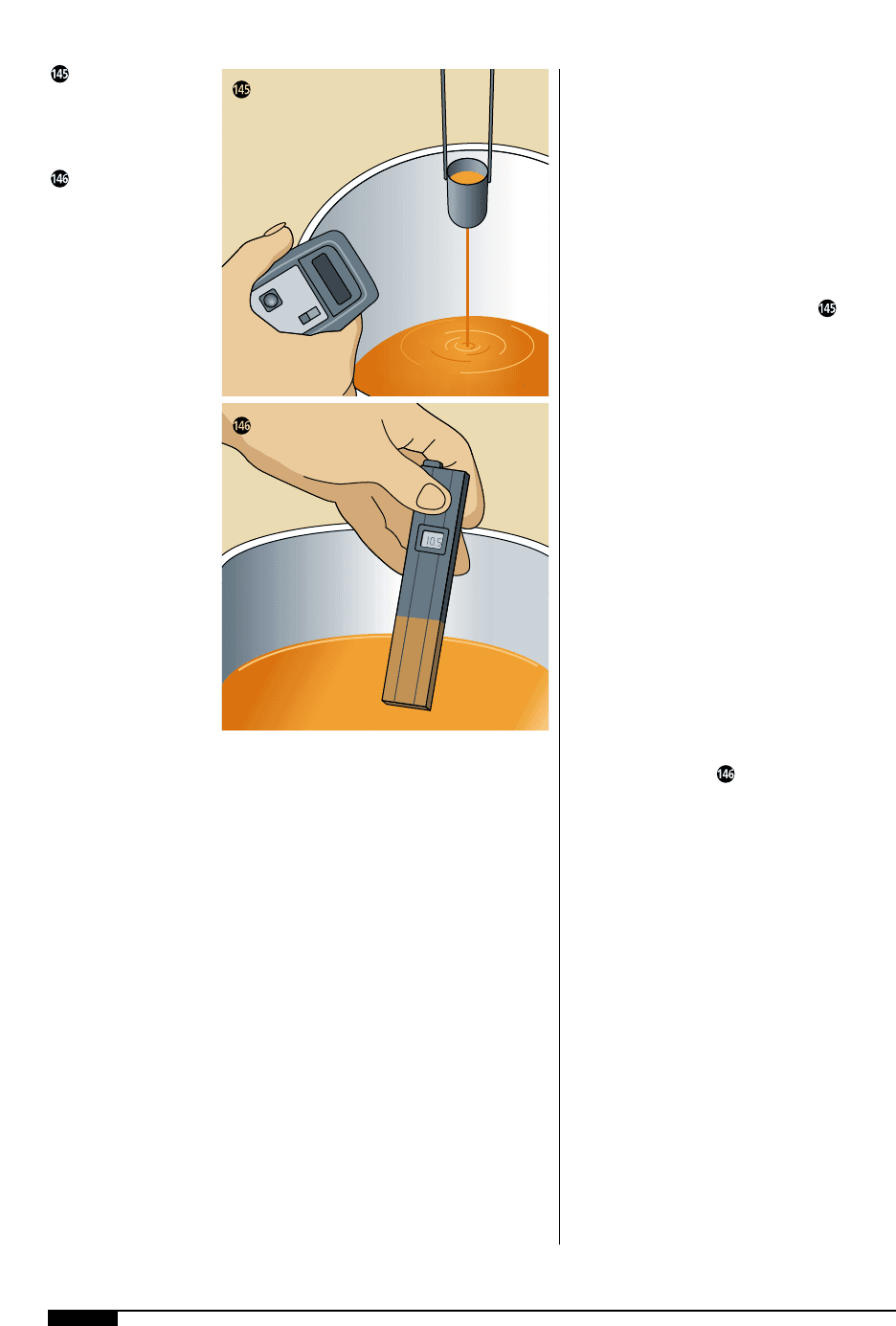
200 FLEXOGRAPHY: PRINCIPLES & PRACTICES
higher percentage of the fast solvent than the
solvent in the system. For example, if the ink
system is 10% normal propyl acetate and 90%
normal propyl alcohol, the acetate is the fast
solvent and will tend to evaporate faster than
the alcohol, which is the slow solvent in the
blend. The make-up solvent should be a slight-
ly higher concentration of acetate to keep the
ink stable, as well as maintain the viscosity
during longer runs.
To control viscosity in water-based ink
systems, water and amine are used. A stabi-
lizing varnish may also be used. Stabilizing
varnish is a water and amine combination
that has been premixed to the correct per-
centages for the ink system being used. An
addition of stabilizing varnish should lower
the ink viscosity while maintaining the pH of
the ink. Water alone will reduce the viscosi-
ty, but it may also reduce pH, which causes
other print problems.
Many wide-web presses used for long runs
are equipped with automatic viscosity con-
trollers. Viscosity controllers dispense a pre-
determined amount of solvent into the ink
system to keep the ink stable throughout the
pressrun. It is important, however, to check
the viscosity manually (Figure ) when
using these controllers to ensure that the
they are working properly.
Water-based inks should be run in a spe-
cific pH range to keep them working effi-
ciently. The pH range varies by ink manufac-
turer and the requirements for the job.
Generally, water-based inks are in the pH
range of 8.0 to 9.3. When the pH of a water-
based ink falls too low, the ink will begin to
body and thicken, eventually causing rewet-
ting problems and dirty printing. If the pH is
too high, the viscosity of the ink will be too
low, causing drying or blocking problems.
Color variations and print defects caused by
pH levels can be eliminated by maintaining
pH within its recommended range.
A pH meter is the instrument used to read
pH levels (Figure ). These instruments
should be calibrated to a buffer solution with
a known pH on a regular basis. Similar to vis-
cosity controllers, many presses have auto-
matic pH controllers that check pH and add
predetermined amounts of stabilizer or amine
to maintain the proper pH level in the ink.
Operators should double-check these devices
by reading the pH manually to guarantee they
are working properly during the run.
Adding Ink to the Fountain
During longer runs, the press operator
may be required to add ink to the fountain or
pump. This requires specific attention to
detail. The following procedure details a typ-
ical ink addition procedure:
1. Double-check the ink to be added for
correct color. Do not assume that an
One way of checking
viscosity is by timing
the ink flow through a
Zahn cup.
When using water-
based inks, it is crucial
to maintain a pH in the
range of 8.0 to 9.3.
M
IN
S
E
C
/1
0
0
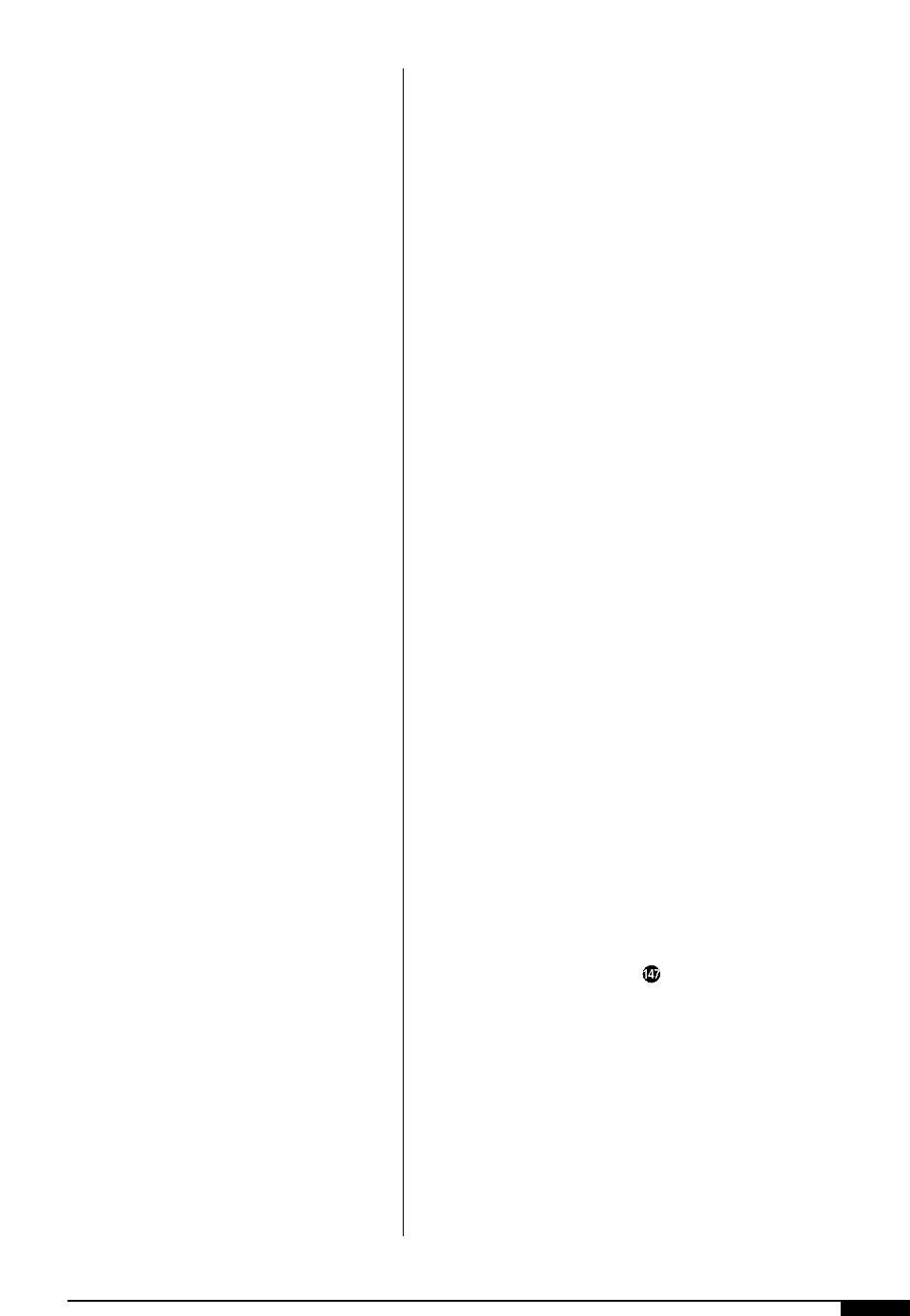
ink container is marked correctly.
2. Adjust viscosity (and pH for water-
based inks), of the ink to be added.
Solvent-based ink to be added to the
fountain should be thinned to a vis-
cosity that is two to four seconds high-
er than the ink in the fountain.
Viscosity of water-based inks should
be five to 10 seconds higher than the
ink in the fountain. Agitation of the ink
will cause a viscosity drop of three to
five seconds.
3. Add only enough ink to bring the level
back to the optimum level.
The optimum level should be determined
before the production run. It is based on the
amount of ink coverage for a given color,
which depends on the ink coverage for the
job being printed. The big print areas that use
more ink will require the ink pans to be filled
more often than those that use little ink. Add
fresh ink each hour to a low coverage area
rather than filling up the fountain and adding
only solvent or stabilizer for the whole shift.
Fresh ink helps maintain the correct balance
between colorant, resin and solvent (water
and amine for water-based ink).
Ink loses printability and flow characteris-
tics if only solvent (water and amine for
water-based inks) is added over a period of
time. This loss is due to the depletion of the
colorant and the resin in the ink.
For the ink to work properly, and to
avoid printability problems, press opera-
tors must know the following about the
inks they are using:
• upper and lower working viscosity
limits;
• solvents and additives to be used;
• range of pH for water inks; and
• maximum pigment load the ink can
handle.
By maintaining the proper percentages of
ink components, the color will be more con-
sistent and fewer print problems will occur.
Inspection and Quality Checks
During a pressrun, the operator should
make ongoing inspections of the press and
the job being printed. The following items
are typical pressrun checks:
• Listen to the press for any unusual noises
that may indicate a mechanical problem.
• Double-check the ink level in the foun-
tain or pumping unit. When using a
pump, check the ink flow to the pan.
• Ensure that the low roll indicator is on.
Prepare for roll changes and splices.
• Monitor print quality with a strobe light,
video monitor or the naked eye.
During the pressrun, print registration may
change and could be caused by the following:
• incorrect web tension between in-feed
and out-feed ends of the press;
• rewind roll tension is too high;
• web splices offsetting the web;
• rolls of stock varying from roll to roll;
• baggy edges on the rolls of stock mov-
ing the web to one side; and
• web thickness and adhesive coating
vary on rolls.
Inspecting a print sample is the most accu-
rate check of print quality. Operators should
not rely on checking print quality on the mov-
ing web alone. Samples of the printed product
must be checked visually with a magnifier for
poor registration, poor ink lay, color drifts,
color match, and ink adhesion or cure. The
operator should be looking for variations in:
• print registration (Figure );
• the cleanliness and sharpness of the
print;
• ink or impression misses;
• ink picking;
• flaws due to plate lift, lint or other
causes; and
• print quality.
Printed samples should be checked
against the color standard on an ongoing
PRESSROOM PRACTICES 201
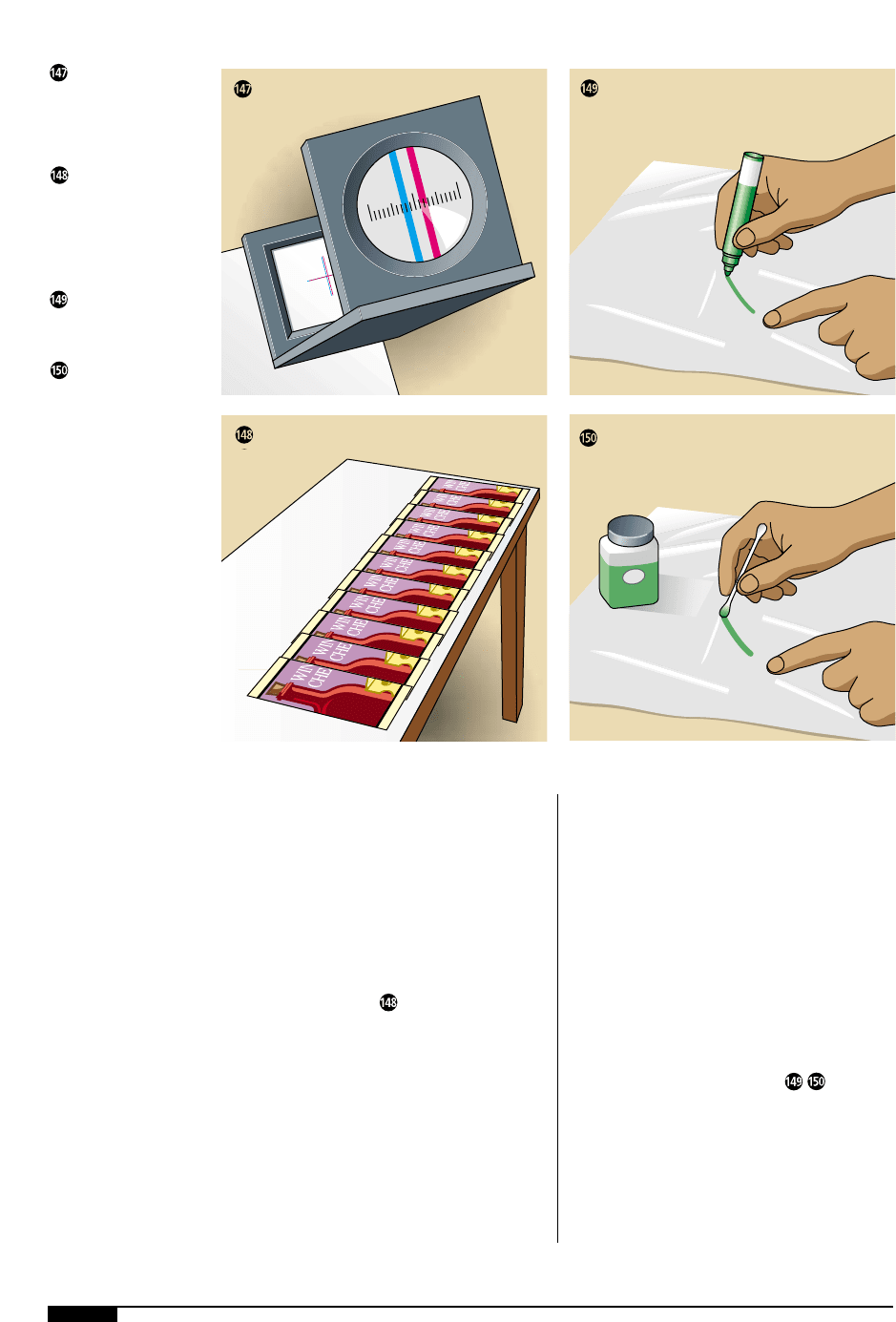
202 FLEXOGRAPHY: PRINCIPLES & PRACTICES
basis to ensure consistency throughout the
run. If a densitometer or spectrophotometer
is being used when the job is set up, and dur-
ing the initial color match, it should be used
during the pressrun. Samples from each
printed roll should be evaluated.
Color-drift checks are performed by laying
consecutive samples in a row on a white
background (Figure ).
Ink-adhesion tests are performed by
putting cellophane tape firmly onto the
printed image and pulling slowly upward
from the image for half of the length of the
tape. The remaining tape is pulled quickly off
the other half. The tape is then examined to
see if it is free of ink.
Solvent-based inks typically have a dyne
level of about 23. Water-based inks have a
dyne level of around 30 or higher depending
on the surfactants being used. In order to
have good ink transfer and adhesion, the
film being printed should have a dyne level
approximately 10 levels higher than the ink
being used.
Flexographic printing on film generally re-
quires that the film be treated, which changes
the surface of the substrate so that the ink can
adhere. The amount of treatment on a film is
measured in dynes with a special solution
using pens or liquids (Figures ).
Quality Awareness
The flexographic printing process requires
consistent and careful monitoring during the
pressrun. There are no assurances that a job
printing well presently will be doing so in five
A magnifier can be
used to check for
errors in print
registration.
A color-drift check
is accomplished by
placing consecutive
samples in a row on a
white background.
Conducting a dyne test
with a pen.
Conducting a dyne test
with liquid.
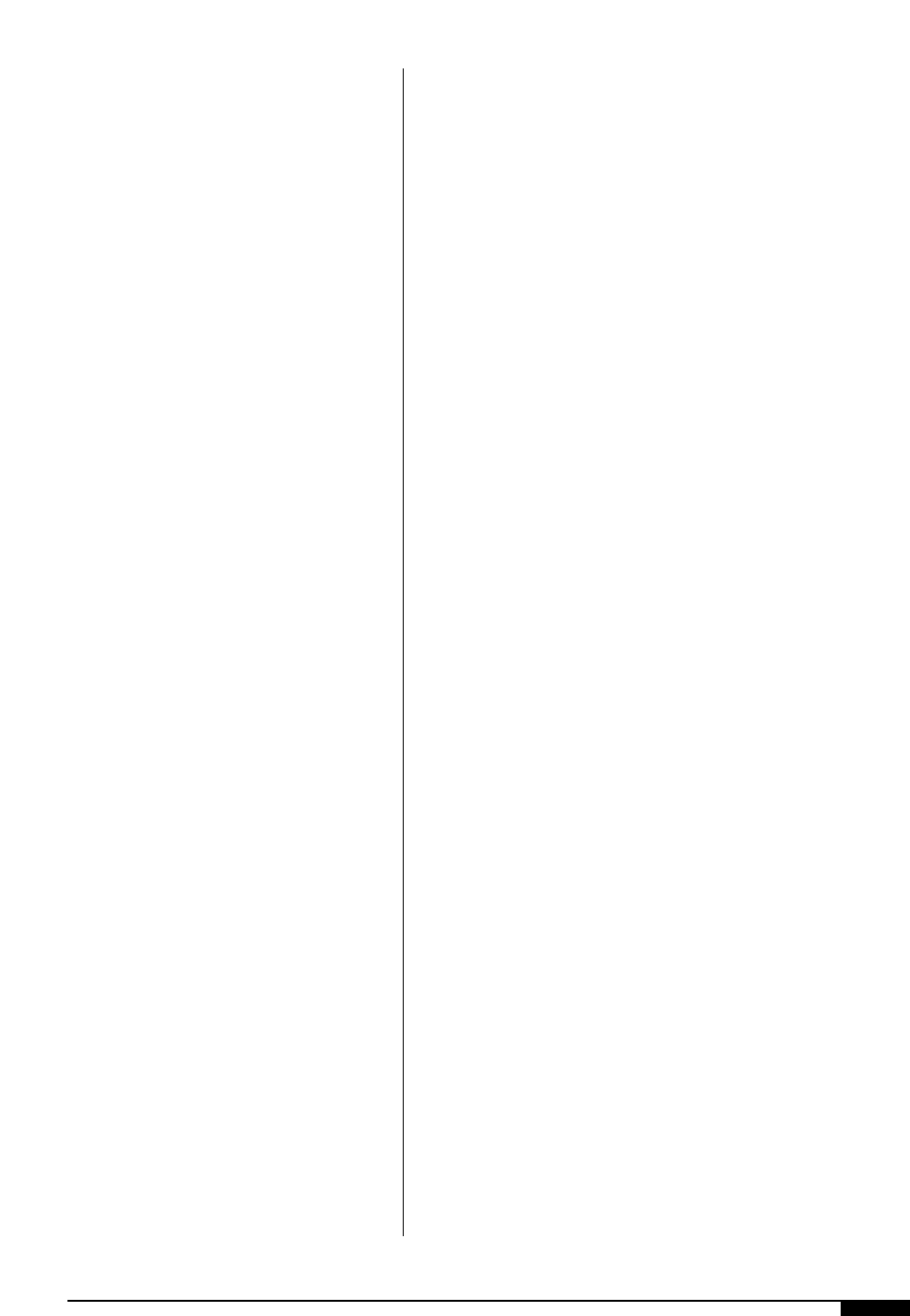
or 10 minutes. Proper pressrun procedures
are the mainstream of top quality finished
products. Press operators must learn and per-
form all pressrun procedures well. Quality
checks should be performed regularly and the
results should be documented. These results
should be kept for a period no less than the
life of the product produced. Quality is the
result of conscious effort by the operator.
Preparing for the Next Job
Preparing for an upcoming job is common-
ly done while the current job is running.
Preparation generally requires assembly of
the necessary plate rolls, substrates, inks,
cores and tooling. The press operator and
assistants should perform the following acti-
vities in preparation for the next job:
• review information in the next job jacket;
• plan print station wash-ups;
• note required inks and colors;
• note colors and anilox rolls in current
use that may be needed; and
• gather all materials and supplies in
advance.
CLEANUP PROCEDURES
Most jobs require some degree of cleanup
upon the completion of a run. Inks for the
next run are often different, which requires
that the press equipment be washed. Since
the press is profitable only when it is in pro-
duction, an efficient cleanup program is
needed. A correct wash-up procedure mini-
mizes downtime between jobs and main-
tains the press in good working condition.
Cleanup procedures vary by company and
brand of equipment.
Before the actual cleanup, the operator
should double-check the next order to deter-
mine if any inks can remain for the next job.
Preliminary Cleanup Steps
The following preliminary steps should be
taken before starting the cleanup process:
1. Cover the lower decks with scrap
material to protect them from ink drips
caused by washing an upper deck.
2. Position ladders needed to reach the
upper decks.
3. Move ink decks away from the impres-
sion cylinder if appropriate.
4. Fill a container with wash-up solution
and place it near the print station.
5. Get an empty container to catch wash-
up solution coming from the ink pan.
In an effort to conserve ink, the operator
should lower the ink pan and squeegee the ink
down the ink return hose and into the ink
pump before wash-up begins. The return hose
should be switched to the wash-up container,
at which point the clean up process begins.
Two-roll Station Cleanup
The following procedure details a typical
cleanup for a two roll system:
1. Turn off the ink pump and disconnect
the power supply to stop the flow of ink.
2. Pump cleaning solution through the
entire system. This pumping makes the
entire system easier to clean.
3. Remove the ink supply hose from the
deck.
4. Stop the rotation of the rubber roll.
5. Release the pressure between the rub-
ber roll and the anilox roll.
6. Move the ink return hose from the ink
pump to the wash-up container.
7. Reset pressure between the anilox and
rubber roll and restart their rotation.
8. Flood the anilox and rubber roll with
wash-up solution as they slowly turn.
The solution will remove ink from the
surface of the rolls. Thorough cleaning
may require several passes over the rolls
with fresh solution to remove the ink.
9. Release the pressure between the ani-
lox roll and rubber roll on one end only.
10. Wipe the anilox roll. Begin on the side
with the released pressure. Use a folded
PRESSROOM PRACTICES 203

204 FLEXOGRAPHY: PRINCIPLES & PRACTICES
rag or shop towel soaked with cleaning
solution. If water-based ink is being
washed up, it is best to keep the foun-
tain roll and anilox roll wet until the ink
is washed off, otherwise the dried ink
will be difficult to clean later.
11. When the end of the roll is reached,
release the pressure on the remaining
end. Finish wiping the anilox roll.
12. Clean the rubber roll the same way as
the anilox roll.
13. Stop the rotation of the rubber roll and
thoroughly clean both ends of the
anilox and rubber roll.
14. Go over each roll with propyl alcohol to
remove any residue left from the soap
used to clean water-based inks.
The print station of a two-roll system con-
tains pinch points between various rolls.
These pinch points are referred to as
inward nips (Figure ). The person clean-
ing the print station must use extreme care
in this area because it is easy to catch a rag
or finger in the nip.
Chamber-bladed Station Cleanup
The following procedure details a typical
cleanup for a chamber blade system:
1. Disengage the doctor blade assembly
from the anilox.
2. Lock the blade assembly into the clean-
up position using the appropriate safe-
ty mechanism.
3. Clean the anilox roll by passing a fold-
ed clean rag or towel soaked in cleanup
solution along the entire face of the roll
as it rotates.
4. Turn off the anilox drive motor and
wash both ends of the anilox thor-
oughly.
5. Carefully remove any ink buildup from
the sides of the anilox.
6. Make a final pass with a clean damp
rag. Follow with a clean dry rag to fin-
ish the cleaning process.
Extreme caution is required when cleaning
the anilox roll when a doctor blade is being
used. The cleanup person must be aware of
the location of the blade to avoid accidental
bumping while cleaning. Doctor blades are
extremely sharp and can cause severe injury.
Cleaning the Plates
When cleaning solvent-based ink off of the
plates, the solvent blend for the ink system
should be used. Excessive amounts of
acetate should be avoided, as it will damage
the plates. When cleaning water-based ink off
of plates, a cleanup soap should be used
(Figure ). A soft-bristled brush may be
used to scrub the plate clean after the solvent
or soap is applied to the plate. The plates
The area where two
rolls meet is known as
a nip zone. Care must
be taken to avoid
catching fingers or
rags in nip zones
during cleaning.
Use extreme care when
cleaning the plates.
Impression
Cylinder
Plate Cylinder
Fountain Roll
Anilox Roll
Nip Roll
Danger
Zone
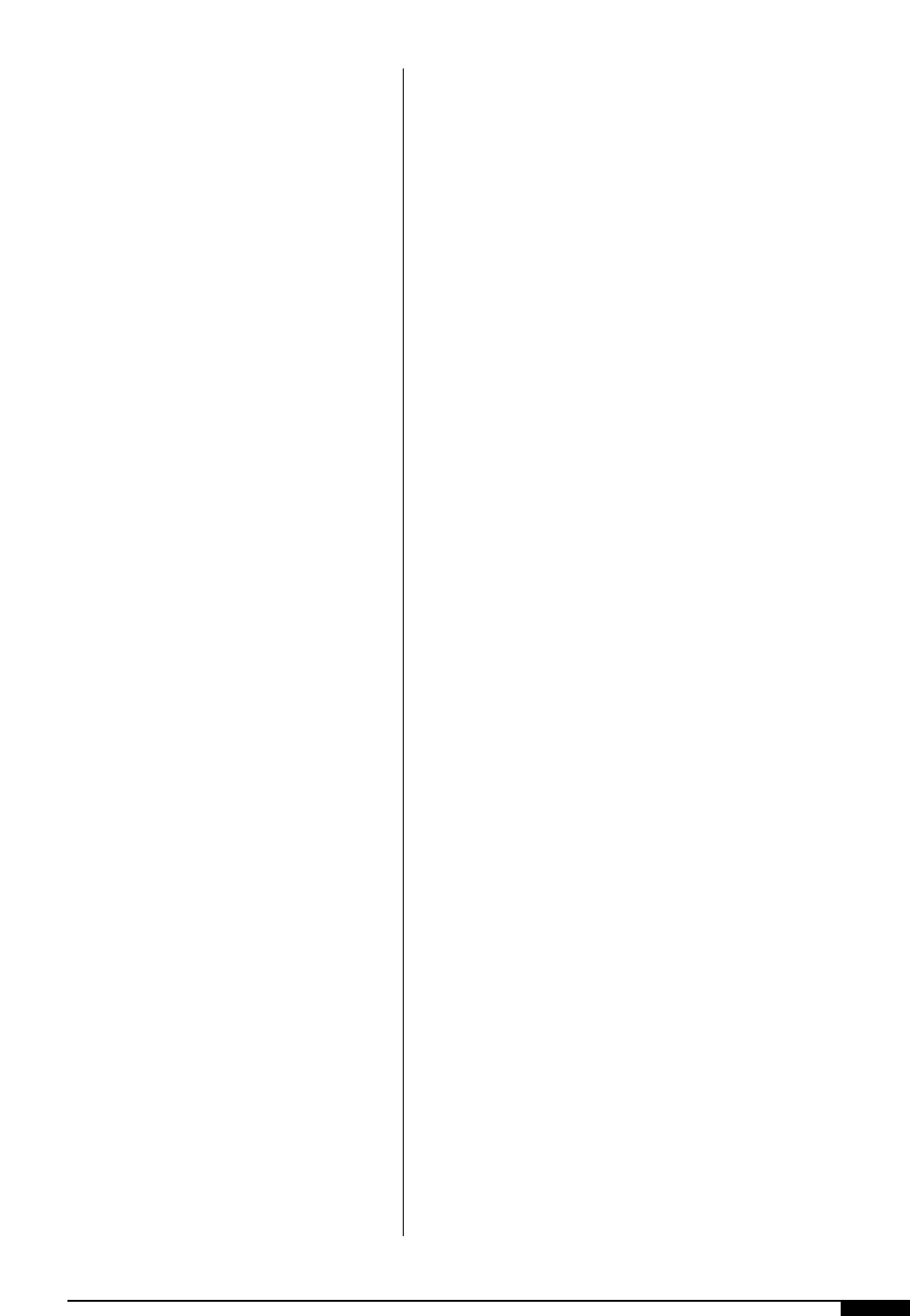
should be blotted dry with a rag or absorbent
towel. Avoid rubbing the plate, as this may
damage the plate image.
After the plate is clean, ink on the cylin-
ders and gears should be removed. The oper-
ator should make note of any damaged or
worn plates and identify any defects so new
plates can be ordered for the next run of that
job. A bad cylinder or gear should be report-
ed so it can be repaired or replaced.
Doctor-blade Assembly Cleanup
Cleaning the doctor-blade assembly re-
quires direct contact with the doctor blade.
Cut-resistant gloves should be worn to mini-
mize the risk of injury. In some cases, the
blade assembly is removed from the press for
cleanup. The following procedure details a
typical cleanup for a doctor blade assembly:
1. Soak a shop rag or towel in cleaning
solution and wipe the inside and out-
side of the assembly. Also wipe both
sides of the blade. Light pressure will
reduce the chance of the blade cutting
through the rag.
2. Check the condition of the doctor blade.
Carefully remove blades that show
excessive wear or damage. Dispose of
blades in a designated container.
3. Continue cleaning the blade assembly
with a soaked rag until most of the ink
on the assembly is gone. Complete a
final pass with a clean damp rag to
remove any last traces of ink.
Operators must remember that the anilox
roll is already clean. Splatters that land on
the roll surface from cleaning the assembly
must be removed.
Replacing a Doctor Blade
If a worn or damaged doctor blade must
be replaced, the blade assembly may need to
be removed from the station. The following
procedure details replacing the doctor
blade:
1. Loosen and/or remove the hold-down
bolts.
2. Remove the doctor blade using slow,
steady pressure. Work carefully along
the length of the blade holder, pulling
short 6" to 9" sections until the blade is
totally removed.
3. Clean all ink from the hold-down cavi-
ty to ensure that the new blade will sit
in the assembly properly.
4. Install a new blade in the hold-down
cavity.
5. Tighten the hold-down bolts slightly,
working from the center out to each
end.
6. Tighten down the hold-down bolts all
the way, again working from the cen-
ter out to the ends to ensure the blade
is seated evenly.
In many cases, the blade assembly must be
broken down to allow for further cleaning
before the new blade is installed. This step
removes any pooled ink from inside the hold-
er. It is especially important if the next run
has a contrasting ink color that can be conta-
minated by the old ink color.
When cleaning up water-based inks, the
doctor-blade assembly should be thoroughly
dried. Moisture trapped within parts of the
assembly can result in rust damage. The
assembly should be set on end to dry rather
than face down to ensure that the moisture
can escape.
Cleanup Ink Pans
The next step after washing the doctor-
blade system is cleaning the ink pans. The
following procedure details a typical ink
pan cleanup:
1. Put the pan into position for washing.
Scrape any liquid ink into the drain
hole.
2. Place a rag at the bottom of the ink pan
and saturate it with cleaning solution.
3. Pass the rag over the entire interior of
PRESSROOM PRACTICES 205
